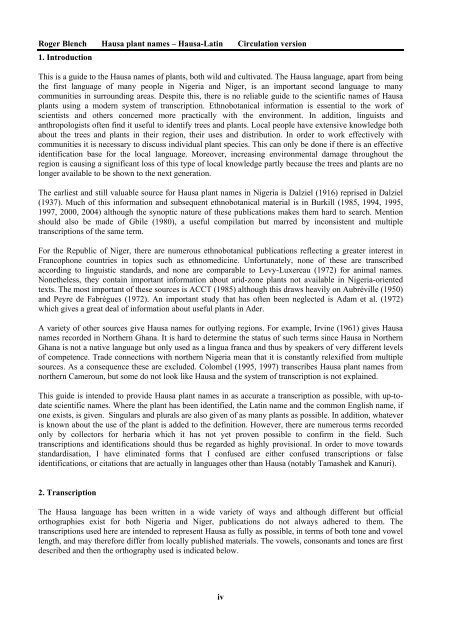HAUSA NAMES FOR PLANTS AND TREES - Roger Blench
HAUSA NAMES FOR PLANTS AND TREES - Roger Blench
HAUSA NAMES FOR PLANTS AND TREES - Roger Blench
Create successful ePaper yourself
Turn your PDF publications into a flip-book with our unique Google optimized e-Paper software.
<strong>Roger</strong> <strong>Blench</strong> Hausa plant names – Hausa-Latin Circulation version<br />
1. Introduction<br />
This is a guide to the Hausa names of plants, both wild and cultivated. The Hausa language, apart from being<br />
the first language of many people in Nigeria and Niger, is an important second language to many<br />
communities in surrounding areas. Despite this, there is no reliable guide to the scientific names of Hausa<br />
plants using a modern system of transcription. Ethnobotanical information is essential to the work of<br />
scientists and others concerned more practically with the environment. In addition, linguists and<br />
anthropologists often find it useful to identify trees and plants. Local people have extensive knowledge both<br />
about the trees and plants in their region, their uses and distribution. In order to work effectively with<br />
communities it is necessary to discuss individual plant species. This can only be done if there is an effective<br />
identification base for the local language. Moreover, increasing environmental damage throughout the<br />
region is causing a significant loss of this type of local knowledge partly because the trees and plants are no<br />
longer available to be shown to the next generation.<br />
The earliest and still valuable source for Hausa plant names in Nigeria is Dalziel (1916) reprised in Dalziel<br />
(1937). Much of this information and subsequent ethnobotanical material is in Burkill (1985, 1994, 1995,<br />
1997, 2000, 2004) although the synoptic nature of these publications makes them hard to search. Mention<br />
should also be made of Gbile (1980), a useful compilation but marred by inconsistent and multiple<br />
transcriptions of the same term.<br />
For the Republic of Niger, there are numerous ethnobotanical publications reflecting a greater interest in<br />
Francophone countries in topics such as ethnomedicine. Unfortunately, none of these are transcribed<br />
according to linguistic standards, and none are comparable to Levy-Luxereau (1972) for animal names.<br />
Nonetheless, they contain important information about arid-zone plants not available in Nigeria-oriented<br />
texts. The most important of these sources is ACCT (1985) although this draws heavily on Aubréville (1950)<br />
and Peyre de Fabrègues (1972). An important study that has often been neglected is Adam et al. (1972)<br />
which gives a great deal of information about useful plants in Ader.<br />
A variety of other sources give Hausa names for outlying regions. For example, Irvine (1961) gives Hausa<br />
names recorded in Northern Ghana. It is hard to determine the status of such terms since Hausa in Northern<br />
Ghana is not a native language but only used as a lingua franca and thus by speakers of very different levels<br />
of competence. Trade connections with northern Nigeria mean that it is constantly relexified from multiple<br />
sources. As a consequence these are excluded. Colombel (1995, 1997) transcribes Hausa plant names from<br />
northern Cameroun, but some do not look like Hausa and the system of transcription is not explained.<br />
This guide is intended to provide Hausa plant names in as accurate a transcription as possible, with up-todate<br />
scientific names. Where the plant has been identified, the Latin name and the common English name, if<br />
one exists, is given. Singulars and plurals are also given of as many plants as possible. In addition, whatever<br />
is known about the use of the plant is added to the definition. However, there are numerous terms recorded<br />
only by collectors for herbaria which it has not yet proven possible to confirm in the field. Such<br />
transcriptions and identifications should thus be regarded as highly provisional. In order to move towards<br />
standardisation, I have eliminated forms that I confused are either confused transcriptions or false<br />
identifications, or citations that are actually in languages other than Hausa (notably Tamashek and Kanuri).<br />
2. Transcription<br />
The Hausa language has been written in a wide variety of ways and although different but official<br />
orthographies exist for both Nigeria and Niger, publications do not always adhered to them. The<br />
transcriptions used here are intended to represent Hausa as fully as possible, in terms of both tone and vowel<br />
length, and may therefore differ from locally published materials. The vowels, consonants and tones are first<br />
described and then the orthography used is indicated below.<br />
iv

















